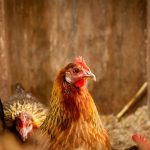The hip joint in chickens is a vital component of their skeletal structure, facilitating movement and mobility. It is a ball-and-socket joint, where the femur’s head fits into the pelvis’s acetabulum, allowing for a wide range of motion necessary for walking, running, and foraging. The joint is supported by ligaments, tendons, and muscles, which provide stability and strength.
Cartilage lines the hip joint, cushioning the bones and reducing friction during movement. This cartilage is crucial for smooth, pain-free joint operation. Synovial fluid within the joint lubricates and nourishes the cartilage, ensuring smooth movement without discomfort.
The chicken hip joint is a complex and essential part of their anatomy, enabling necessary movement and activity. The health and function of the hip joint are critical for a chicken’s overall well-being. Any issues with this joint can significantly impact the bird’s ability to move, forage, and engage in normal activities.
Chicken owners should be aware of signs and symptoms related to hip joint problems, as well as potential causes and treatment options, to ensure the health and comfort of their birds.
Table of Contents
Key Takeaways
- The chicken hip joint is a ball-and-socket joint that allows for movement and flexibility.
- Signs of a popping chicken hip joint include limping, difficulty walking, and audible popping or clicking sounds.
- Causes of a popping chicken hip joint can include injury, genetic predisposition, or developmental issues.
- Treatment options for a popping chicken hip joint may include rest, physical therapy, or surgery in severe cases.
- Preventing a popping chicken hip joint involves providing a balanced diet, proper housing, and regular exercise for your chickens.
Signs and Symptoms of a Popping Chicken Hip Joint
Physical Signs of a Popping Hip Joint
Additionally, the chicken may exhibit signs of discomfort or pain when using the affected leg, such as limping or favoring one side. Another symptom of a popping hip joint is a reduced range of motion in the affected leg. The chicken may have difficulty moving the leg or may exhibit stiffness when attempting to walk or engage in physical activity. In some cases, swelling or inflammation around the hip joint may also be present, indicating an underlying issue with the joint.
Behavioral Changes Associated with a Popping Hip Joint
In addition to these physical signs, changes in behavior may also indicate a popping hip joint in chickens. The affected bird may exhibit signs of distress or irritability, as well as a reluctance to engage in normal activities such as foraging or roosting. These behavioral changes can be indicative of pain or discomfort associated with a popping hip joint.
Importance of Early Detection and Intervention
Overall, being attentive to these signs and symptoms can help chicken owners identify and address issues with their bird’s hip joint promptly. It is essential for chicken owners to observe their birds closely for any signs of discomfort or abnormal movement that may indicate a problem with the hip joint.
Causes of a Popping Chicken Hip Joint

There are several potential causes of a popping hip joint in chickens, ranging from injury to underlying health conditions. One common cause is trauma or injury to the hip joint, which can occur due to falls, collisions, or other accidents. These injuries can lead to damage to the ligaments, tendons, or cartilage within the hip joint, resulting in instability and a popping sensation during movement.
Additionally, overexertion or excessive physical activity can also lead to strain or injury to the hip joint, causing discomfort and popping sounds. Another potential cause of a popping hip joint in chickens is developmental issues or genetic predisposition. Some chickens may be born with structural abnormalities in their hip joint, such as hip dysplasia, which can lead to instability and popping sensations during movement.
These developmental issues can manifest at a young age and may worsen over time if left untreated. Furthermore, certain health conditions such as arthritis or avian osteoporosis can also contribute to a popping hip joint in chickens, as these conditions can affect the integrity and function of the hip joint. Environmental factors such as poor nutrition or inadequate living conditions can also impact the health of the hip joint in chickens.
A lack of essential nutrients such as calcium and vitamin D can lead to weakened bones and cartilage, increasing the risk of hip joint issues. Similarly, overcrowding or unsuitable living conditions can lead to stress and physical strain on the birds, potentially contributing to hip joint problems. Overall, understanding the potential causes of a popping hip joint can help chicken owners take proactive measures to prevent and address these issues.
Treatment Options for a Popping Chicken Hip Joint
When it comes to treating a popping hip joint in chickens, there are several options available to address the underlying issue and alleviate discomfort for the affected bird. One common treatment approach is rest and restricted activity, allowing the affected chicken to recover from any injury or strain on the hip joint. By limiting physical activity and providing a comfortable and supportive environment, chicken owners can help reduce stress on the hip joint and promote healing.
In cases where trauma or injury has occurred, supportive care such as applying cold compresses or providing pain relief medication may be necessary to manage discomfort and inflammation. Additionally, physical therapy and gentle exercise may be beneficial for strengthening the muscles around the hip joint and improving range of motion. These exercises should be performed under the guidance of a veterinarian to ensure they are safe and effective for the affected bird.
In more severe cases or those related to developmental issues or health conditions, surgical intervention may be necessary to address the underlying problem with the hip joint. Procedures such as hip replacement or corrective surgery may be recommended by a veterinarian to restore function and stability to the affected joint. These interventions require careful consideration and should be discussed thoroughly with a qualified veterinarian to determine the best course of action for the affected bird.
Furthermore, supportive care such as providing a balanced diet rich in essential nutrients and ensuring suitable living conditions can help promote overall health and well-being for chickens with a popping hip joint. By addressing any underlying health issues and providing proper care, chicken owners can help their birds recover from hip joint problems and prevent future issues from arising.
Preventing a Popping Chicken Hip Joint
Preventing a popping hip joint in chickens involves proactive measures to promote overall musculoskeletal health and reduce the risk of injury or strain on the hip joint. One essential aspect of prevention is providing a suitable living environment for chickens, including ample space for exercise and foraging. Overcrowding can lead to stress and physical strain on birds, increasing the risk of musculoskeletal issues such as a popping hip joint.
Additionally, ensuring a balanced diet rich in essential nutrients such as calcium and vitamin D is crucial for maintaining strong bones and cartilage in chickens. A diet that meets their nutritional needs can help prevent issues such as avian osteoporosis and reduce the risk of hip joint problems. Providing access to natural sunlight or supplemental lighting can also help chickens produce vitamin D, essential for bone health.
Regular veterinary check-ups are also important for monitoring the overall health and well-being of chickens, including their musculoskeletal system. A veterinarian can assess any potential issues with the hip joint and provide guidance on preventive measures to keep chickens healthy and active. Furthermore, implementing safe handling practices and minimizing potential hazards in the chicken’s environment can help reduce the risk of accidents or injuries that could impact their hip joint.
By taking these preventive measures into consideration, chicken owners can help reduce the risk of a popping hip joint in their birds and promote overall musculoskeletal health.
When to Seek Veterinary Care for a Popping Chicken Hip Joint

Early Detection and Veterinary Care
As a chicken owner, it is crucial to be vigilant about any signs or symptoms of a popping hip joint in your birds and seek veterinary care promptly when necessary. If your chicken exhibits persistent signs of discomfort or abnormal movement associated with their hip joint, it is essential to consult with a veterinarian for an accurate diagnosis and appropriate treatment plan.
The Importance of Prompt Veterinary Attention
Additionally, if an injury or trauma has occurred that may have impacted the hip joint, veterinary care should be sought immediately to assess the extent of the damage and provide necessary care for the affected bird. Delaying veterinary care in such cases can lead to further complications and hinder the bird’s recovery.
When to Seek Further Veterinary Attention
Furthermore, if a chicken’s condition does not improve with rest and supportive care, it is important to seek veterinary attention to determine if there are underlying health issues contributing to their popping hip joint. A veterinarian can conduct a thorough examination and diagnostic tests to identify any potential causes and recommend appropriate treatment options.
Proactive Care for a Timely Recovery
Overall, being proactive about seeking veterinary care when a popping hip joint is suspected can help ensure that chickens receive timely and effective treatment for their condition.
Caring for Your Chicken’s Hip Joint
Caring for your chicken’s hip joint is essential for promoting their overall health and well-being. Understanding the anatomy of the hip joint, recognizing signs and symptoms of a popping hip joint, identifying potential causes, and knowing when to seek veterinary care are all crucial aspects of caring for your bird’s musculoskeletal health. By taking preventive measures such as providing a suitable living environment, ensuring a balanced diet rich in essential nutrients, and implementing safe handling practices, chicken owners can help reduce the risk of a popping hip joint in their birds.
Additionally, being attentive to any signs of discomfort or abnormal movement associated with the hip joint and seeking veterinary care promptly when necessary can help ensure that chickens receive timely and appropriate treatment for their condition. Overall, by being proactive about caring for your chicken’s hip joint, you can help promote their mobility, comfort, and overall quality of life.
If you’re concerned about your chicken’s hip joint popping, you may want to consider the importance of providing a comfortable and spacious chicken coop. According to a recent article on PoultryWizard, a well-designed chicken coop in Grand Island, NE, can help prevent joint issues and promote overall health for your flock. Check out the article here for more tips on creating the perfect coop for your chickens.
FAQs
What causes a chicken’s hip joint to keep popping?
The popping sound in a chicken’s hip joint can be caused by a variety of factors, including injury, arthritis, or a genetic predisposition to joint issues. It is important to have a veterinarian examine the chicken to determine the specific cause of the popping.
Is it normal for a chicken’s hip joint to pop?
While some occasional popping or clicking in a chicken’s hip joint may be normal, persistent or frequent popping can indicate an underlying issue that should be addressed by a veterinarian.
How can I help my chicken with a popping hip joint?
If you notice your chicken’s hip joint popping, it is important to seek veterinary care to determine the cause and appropriate treatment. This may include rest, medication, physical therapy, or other interventions to alleviate discomfort and improve joint function.
Can a chicken’s hip joint popping be treated?
The treatment for a chicken’s popping hip joint will depend on the underlying cause. In some cases, conservative management such as rest and supportive care may be sufficient, while in other cases, more intensive interventions such as surgery may be necessary.
Can a chicken with a popping hip joint still lead a normal life?
With appropriate veterinary care and management, many chickens with a popping hip joint can lead relatively normal lives. However, the prognosis will depend on the specific cause of the popping and the individual bird’s response to treatment.
Meet Walter, the feathered-friend fanatic of Florida! Nestled in the sunshine state, Walter struts through life with his feathered companions, clucking his way to happiness. With a coop that’s fancier than a five-star hotel, he’s the Don Juan of the chicken world. When he’s not teaching his hens to do the cha-cha, you’ll find him in a heated debate with his prized rooster, Sir Clucks-a-Lot. Walter’s poultry passion is no yolk; he’s the sunny-side-up guy you never knew you needed in your flock of friends!







